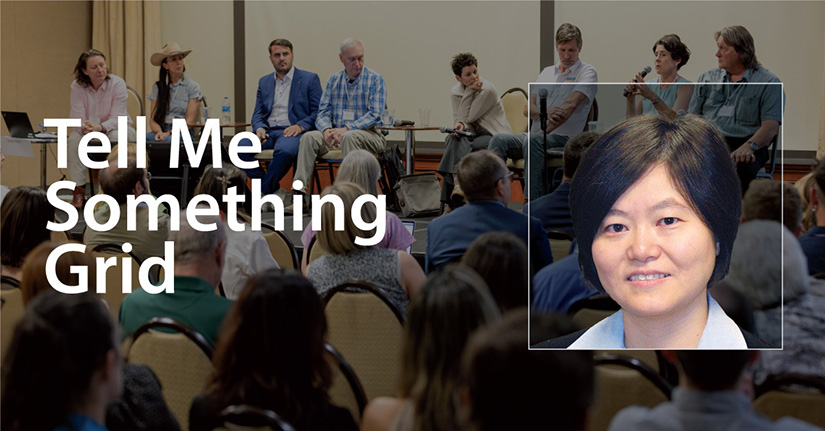How Industry Partnerships Can Help Tackle Real-World Grid Challenges
NREL Chief Scientist Yonghong Chen Shares Why Collaboration Is Key for Planning and Operating the Future Grid

This installment of the National Renewable Energy Laboratory's (NREL's) Tell Me Something Grid series features Yonghong Chen, a member of NREL's Grid Planning and Analysis Center (GPAC) and a Fellow of The Institute of Electrical and Electronics Engineers. Chen shares how her two decades of experience working at an independent system operator is now informing her philosophy on industry collaboration in her current projects at NREL.
The nation's energy landscape is shifting toward renewables—how can we ensure the grid keeps pace?
As the U.S. electricity portfolio evolves, it challenges the traditional tools and methodologies used for grid planning and operations. But by tapping into the collective expertise of electric companies and grid operators, we can come up with innovative solutions to plan and operate the future grid.
Before joining NREL in June 2023, I worked for more than 20 years at Midcontinent Independent System Operator (MISO), which operates one of the largest electricity markets, including 15 states in the Midwestern and Southern United States, plus the Canadian province of Manitoba. At MISO, we collaborated with national laboratories to address the new challenges from increasing renewable energy resources. At NREL, I now have the opportunity to work in the other direction.
My research at NREL focuses on both market design and grid operations, which encompasses regional operational risk management, typically within the weeklong timeframe, and transmission planning, which addresses the future horizon of grid expansion needs.
Efficient Market Design and Operations Can Facilitate More Renewables
Today, two-thirds of electricity consumers in the United States are served by electricity purchased through wholesale electricity markets. The market systems have evolved to optimally balance energy production and system demand at the lowest possible cost while managing transmission constraints to avoid congestion on the grid.
However, the increasing variability and uncertainty from renewable integration introduce challenges to grid operations. Efficient market design and operations can tackle these challenges by co-optimizing cost-effective electricity production with system reliability, ensuring the right resources are available at the right locations. This involves not only optimally scheduling market resources, but also sending market price signals to guide how existing resources should respond during normal and emergency conditions, and where new investment should occur.
Ensuring reliable operations under changing conditions requires new market designs and control room tools, especially as the grid incorporates more variable renewable energy sources and faces more extreme weather events. Our team at NREL is collaborating with grid operators to develop advanced tools to quantify operational risks and inform both market product requirements and operational decisions, as well as evaluating new market products and pricing reforms.
In the long term, planning for the future grid is complicated by the uncertainty of future resource profiles and the development of new technologies. Understanding how to structure markets and planning processes to incentivize appropriate investment (while balancing cost, fairness, and sustainability) is key to ensuring the grid can meet future demand and maintain efficiency and reliability in the long run. Our team at NREL is partnering with universities and industry experts to develop modeling tools and analytical frameworks to study these key issues.
Harmonious Interregional Transmission Through Coordinated Planning and Operations
Successfully incorporating renewables involves more than just market design and operations; it requires comprehensive planning across different regions and timeframes. The National Transmission Planning Study—led by the U.S. Department of Energy's Grid Deployment Office in partnership with NREL and Pacific Northwest National Laboratory—asked: Which large-scale transmission buildout options will provide benefits beyond regional boundaries to electric customers while accelerating decarbonization and maintaining reliability?
Another project I am working on at NREL takes the question a step further and asks how to effectively operate a transmission grid with large transfers across interregional transmission lines. This project examines inefficiencies in existing interregional operational coordination and studies how to effectively coordinate across interconnected regions to achieve the full benefit projected by the National Transmission Planning Study's long-distance transmission scenarios.
To explore this topic, my NREL colleagues and I hosted a workshop in June that brought together grid operators from North America and Europe. Because Europe's approaches to grid planning, operations, and market design are fundamentally different from North America's, we have a lot to learn from each other. To date, our team has developed advanced market simulation software to analyze multiregion coordination in multistage market operations, identified gaps in current operational practices, and created more effective real-time coordination algorithms. In the coming year, we plan to scale our work to study the National Transmission Planning Study's size model.
Industry Collaboration Powers Real-World Solutions
For most of my projects at NREL, I collaborate with industry partners to help bridge the gap between the needs from the industry and the technology research and development activities at the lab. I'm excited for the opportunities to leverage resources from the national laboratories and build stronger connections with the industry.
I'm eager to continue to work with numerous industry collaborators on existing and future projects, which will ultimately help us establish strong relationships and work together to effectively tackle real-world grid challenges.
Read more from NREL's Tell Me Something Grid series, and sign up for NREL's energy analysis newsletter.

